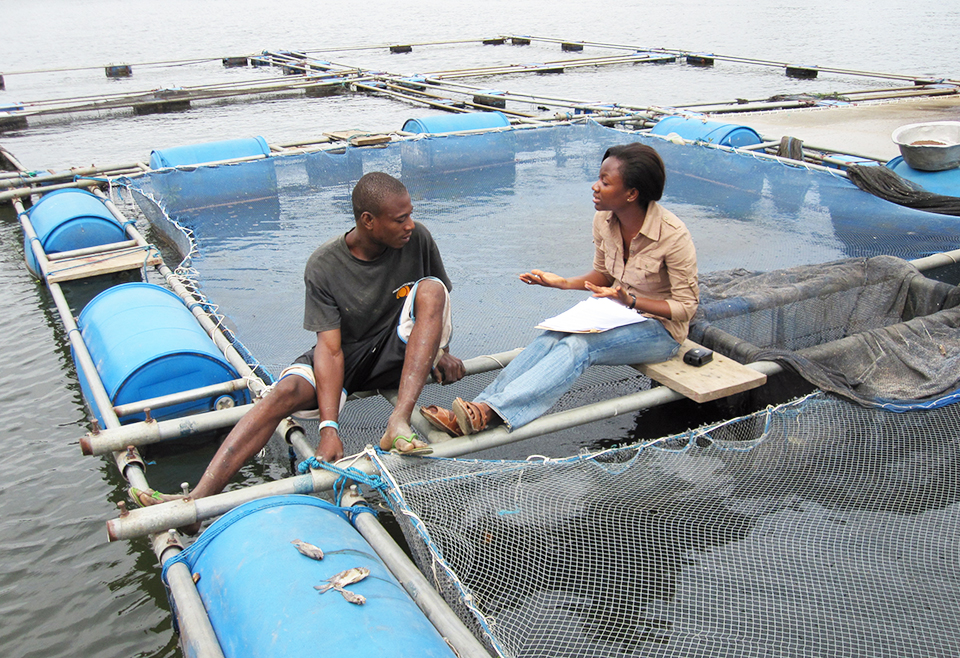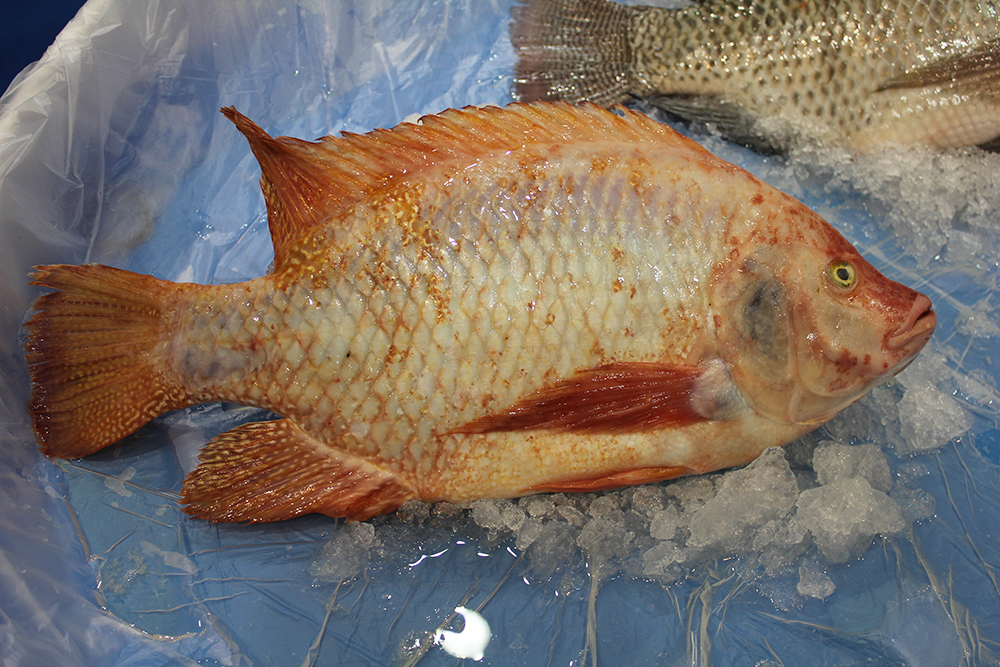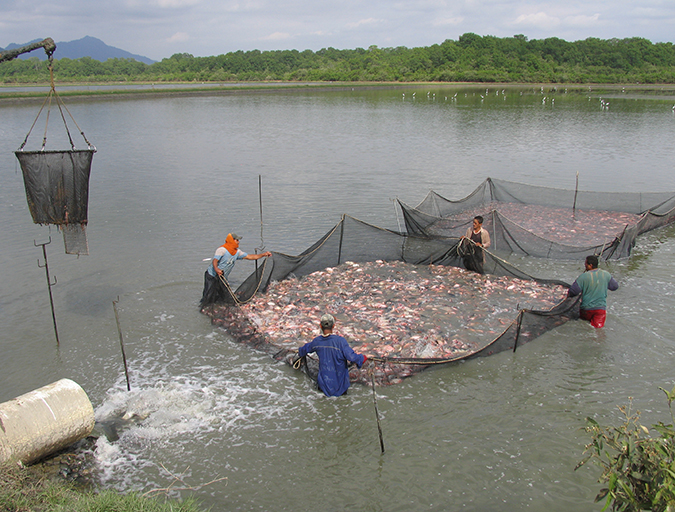Farming with seaweed may improve economic, environmental sustainability

Saudi Arabia occupies 80 percent of the area of the Arabian Peninsula and is bordered by the Red Sea on the west and the Arabian Gulf, which is located between Iran and the Arabian Peninsula on the east. Although its aquaculture production is still smaller than that of the country’s wild-capture fisheries, output has grown substantially from 2,696 metric tons (MT) in 1995 to 22,253 MT in 2008 – providing product with a value of $229 million. This volume represented about 24 percent of fish production in the kingdom.
Aquaculture development
In 2001, there were 149 fish farms. Almost half of their 8,200-MT production was achieved by freshwater fish farms, most of which raised tilapia. Marine aquaculture ponds, particularly shrimp farms on the Red Sea coast in the region of Jizan and Tihama, accounted for the rest of the aquaculture production.
Among the marine fish species that have entered commercial production or are in the pilot phase include grouper (Epinephelus coioides), sea bream (Sparus auratus), net or rabbitfish (Siganus caniculatus) and mullet (Mugilidae species). There is also interest in the culture of lobsters, mollusks, seaweed and ornamental fish.
Rising demand
Although aquaculture is seen as a major source of supply for fresh fish, farmed production has not grown fast enough to meet the growing demand. Therefore, Saudi Arabia will continue to be increasingly dependent on the importation of fishery products to meet its citizens’ needs.
The average annual per-capita consumption of fish in the kingdom is 8 kg, while the World Health Organization recommends that people consume 25 kg/year. The gap between locally produced seafood from fisheries and aquaculture and even the small Saudi per-capita demand is still expanding from population growth and slow growth in fisheries landings. Fish and shrimp farming occupy an important position in ensuring seafood protein and achieving self-sufficiency in supplying seafood.
Table 1 shows the total Nile tilapia production for each region in Saudi Arabia for 2006 through 2008. Riyadh has been the most important region for freshwater tilapia, followed by Mecca, Qasim, Eastern Region and Tabuk.
Al-Ghanem, Tilapia production, Table 1
| Location | Tilapia Production (mt) 2006 | Tilapia Production (mt) 2007 | Tilapia Production (mt) 2008 |
|---|---|---|---|
| Riyadh | 1,828 | 1,916 | 1,816 |
| Mecca | 722 | 627 | 433 |
| Qassim | 691 | 917 | 1,148 |
| Eastern Region | 160 | 30 | 0 |
| Tabuk | 24 | 10 | 0 |
| Hail | 0 | 19 | 16 |
| 3,425 | 3,519 | 3,443 |
Most tilapia farms in Saudi Arabia are private companies. They can reduce production if the economic returns look unprofitable. In addition, tilapia production is not considered important for a country which depends largely on oil production. Similar to the United States, Saudi Arabia is still considered an importing country for tilapia and most fish species.
Tilapia, seaweed system
At the Ministry of Agriculture’s Fish Farming Center near Jeddah Oreochromis spiluris are reared in full-strength seawater with 42-ppt salinity from a seashore well. The fish are used in an integrated multitrophic aquaculture system utilizing the fish effluent to fertilize Ulva and Gracilaria seaweed, which in turn absorb the nitrogen, phosphorus, carbon dioxide and micronutrients from the water. This allows the water to be reused for aquaculture or discharged to the environment without detrimental impacts.
This work is conducted by a team from King Abdulaziz City of Science and Technology and the Ministry of Agriculture Fish Farm Center with expectations of distributing the technology to fish and shrimp operations in Saudi Arabia to improve both economic and environmental sustainability.
Perspectives
Tilapia reared sustainably in highly saline waters would open a huge new potential for Saudi fish farmers. The long seacoasts with moderate temperatures could support substantial new production. Polyculture with shrimp would also offer potential advantages through integration with the large shrimp farms on the Red Sea coast.
Saudi Arabia is poised to substantially increase tilapia production utilizing sustainable integrated farming in both freshwater and marine systems. In addition to Saudi consumers who are looking for additional supplies of high-quality fish, many of the immigrant contract workers in Saudi Arabia and the Gulf states have high traditional regard for tilapia and seaweed, and are important consumers of tilapia produced in Asia. Domestic production of tilapia would appear to benefit all, reducing transportation and retail costs, and providing additional economic diversification within Saudi Arabia.
(Editor’s Note: This article was originally published in the March/April 2011 print edition of the Global Aquaculture Advocate.)
Authors
-
Dr. Khalid A. Al-Ghanem
College of Science and Humanities at Al-Kharj
King Saud University
Riyadh, Saudi Arabia -
Dr. Aftab Alam
Natural Resources and Environment Research Institute
King Abdulaziz City for Science and Technology
Riyadh, Saudi Arabia -
Dr. Yousef S. Al-Hafedh
Natural Resources and Environment Research Institute
King Abdulaziz City for Science and Technology
Riyadh, Saudi Arabia -
Kevin Fitzsimmons, Ph.D.
College of Agriculture and Life Sciences
University of Arizona
2601 East Airport Drive
Tucson, Arizona 85756 USA[117,100,101,46,97,110,111,122,105,114,97,46,103,97,64,122,116,105,102,118,101,107]
Tagged With
Related Posts

Health & Welfare
10 paths to low productivity and profitability with tilapia in sub-Saharan Africa
Tilapia culture in sub-Saharan Africa suffers from low productivity and profitability. A comprehensive management approach is needed to address the root causes.

Health & Welfare
A look at tilapia aquaculture in Ghana
Aquaculture in Ghana has overcome its historic fits and starts and is helping to narrow the gap between domestic seafood production and consumption. Production is based on Nile tilapia.

Intelligence
Adding value to tilapia to tap into U.S. market
New markets for tilapia and expansion of existing ones can be created by planning and implementing properly designed geographic strategies to meet discriminating consumer preferences. Low labor costs in most producing countries promotes value-adding by the production of fresh fillets.

Responsibility
Addressing safety in Latin America’s tilapia supply chain
Over the last decade, the experience gained by many tilapia farmers combined with proficient programs implemented by local governments have significantly improved tilapia production in various Latin American countries like Colombia, Mexico, Ecuador and other important tilapia producers in the region.


